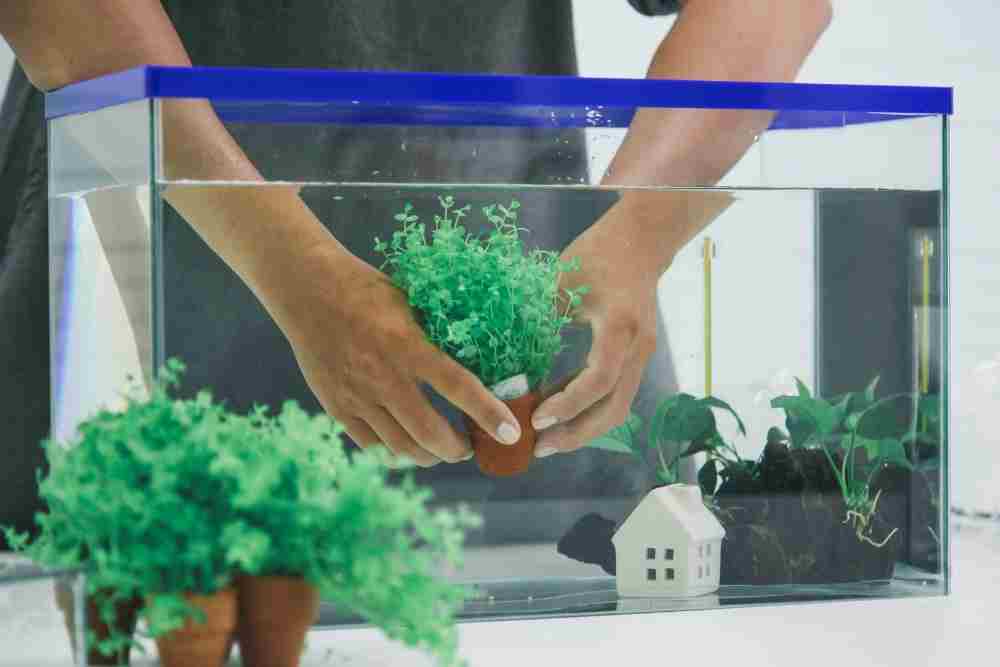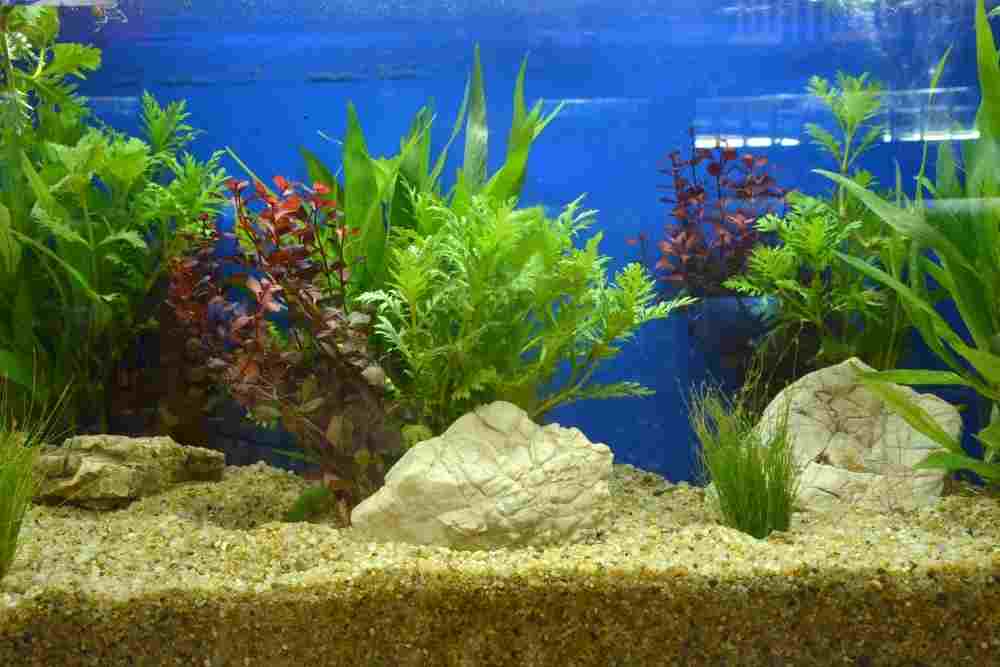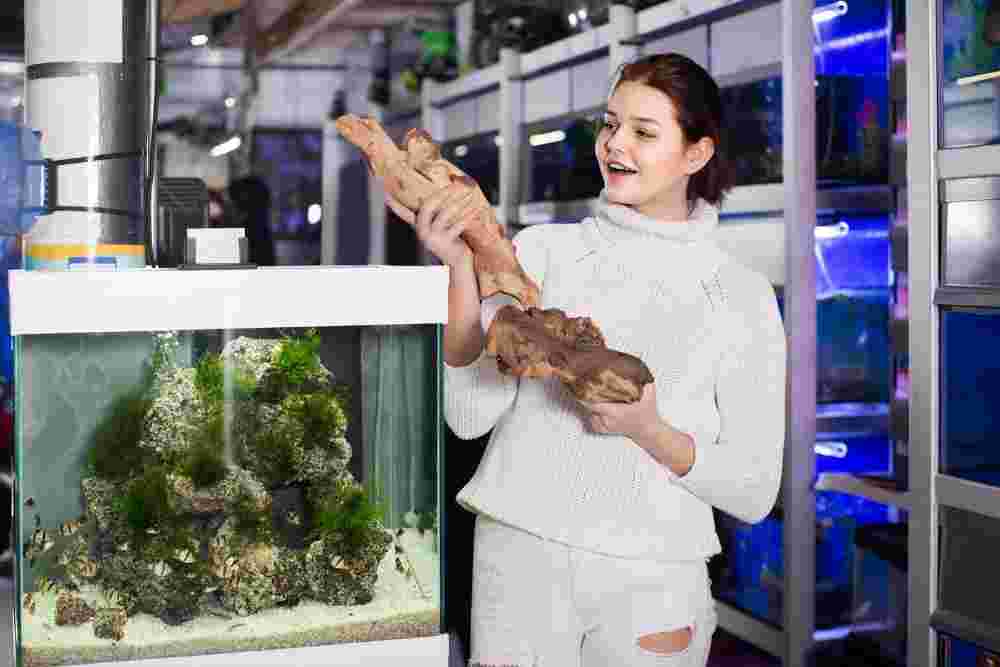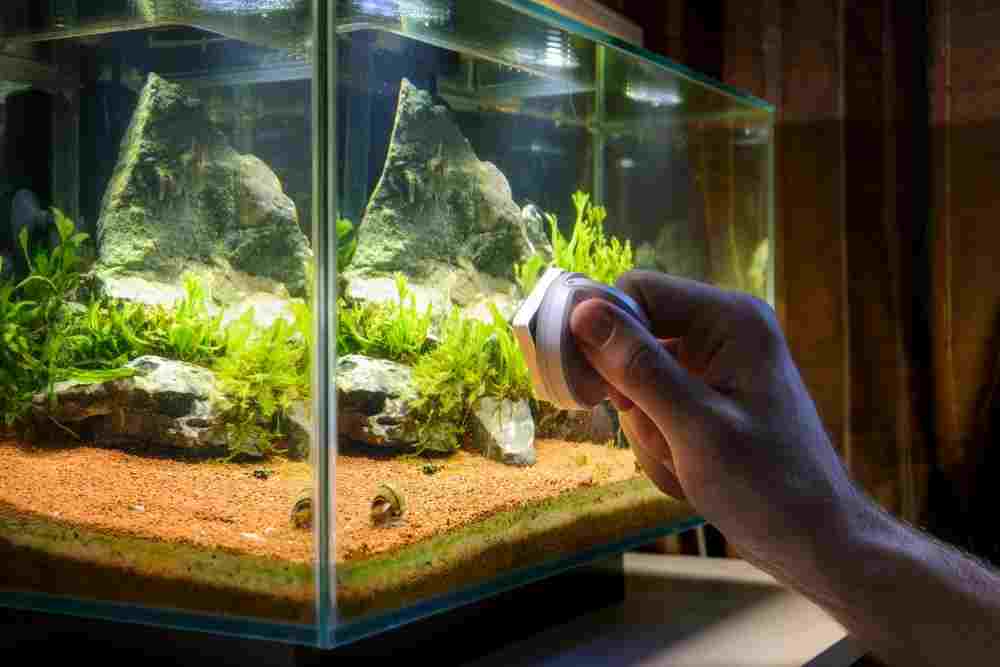Aquariums are amazing pieces of home decor. It’s is necessary to know how to make aquarium decoration safe for aquarium plants and animals.
There are a few things to keep in mind when making aquarium decorations. Firstly, make sure that any materials you use are safe for both fish and humans. Secondly, be careful with sharp objects, as these can easily injure fish. Finally, always rinse decorations before adding them to the tank to remove any excess chemicals or dirt. With these tips in mind, you can safely create beautiful aquarium decorations that both you and your fish will enjoy.
There are many materials that people use in their aquariums without knowing the potential harm they can do. In this article, we will discuss some of the materials you should use some should avoid using in your aquarium.

What is Aquarium
The term aquarium was coined by Philip Henry Gosse – combining the Latin root word “aqua” meaning ‘water’ while adding “rium”, denoting an area for things relating specifically to water or seawater- making it clear that this is where all kinds of creatures can thrive together without much effort.
Aquariums are a way to keep aquatic animals in captivity and beautiful. An aquarium is a vivarium of various sizes with transparent glass sides in which aquatic plants or animals are kept and displayed.
How To Make Aquarium Decoration Safe
When it comes to aquarium decoration, there are a few things to keep in mind in order to make sure it is safe for both your fish and your home. In order to keep an aquarium safe, it is important to take precautions when adding decorations. Here are a few tips to help make your aquarium decoration safe:
Select Suitable Substrate
The substrate is the first thing you purchase for your tank. It comes in a variety of sizes, colors, and shapes but not all will be perfect for your fish. You should always consider what type of substrate to buy based on what species it’s going to house.
Some prefer sand while others like gravel or soft substrates that won’t hurt them during their digging phases. People often think that collecting stones from outside would work well; however, this may lead to polluted water and endanger any occupants if done incorrectly.
Gravel: Gravel is a type of substrate that your aquarium will need to look nice and function properly. Most people choose between two different types: medium-sized or small gravel for plants, large gravels can be difficult because it traps leftover food or even the occasional fish.
Sand: Sand also gives an aquarium’s bottom layer plenty of texture and color variation which would make any tank look natural whether containing lots of aquatic life or just simple decorations with few inhabitants like rocks or shells.
Occasionally, you would have to clean the substrate if you want to take good care of your tank. Take your time, as you want it completely clean. Make sure that the substrates that you collected, are from a good authentic source that will not contaminate the environment of the aquarium.
Select Suitable Plants
Plants are the perfect decoration for an aquarium because they add color to the tank. Some tanks are more natural-looking when you have live plants that come from freshwater environments and can give a home aquarium a more realistic feel.
But most home aquarists don’t use real ones; instead, they go for plastic plants which is easier to maintain than living plants. The fish benefit from these fake green friends too: They offer places where fish can hide.
The idea of having some live plants in an aquarium can be a great benefit to your fish and the quality of water. Plants use nitrogen that is often present as waste products from our fishes, but they also give off oxygen which helps keep pH levels stable.
Fake plants have their own benefits: they do not drop leaves or die. Dead leaves and plants from live plants decompose which can cause nitrogen levels in the tank to spike.
This is sometimes bad for fish health as it stresses them out and if that’s high enough could potentially lead to death. Assure that you are buying your plants in the little sterile test tubes to avoid a very high risk of introducing hitchhiking snails in the aquarium.
Select Aquarium Safe Materials

Plastic
Not all plastics used as decorations are suitable for fish tanks because they may release toxic chemicals into the water which could harm inhabitants within them. If possible always try to avoid plastic toys in your fish tank. Paints can cause toxic substances to seep into the water which could poison your beloved aquatic buddies.
Unsealed paints will release toxins directly, whereas sealed ones have a chance of chipping or splitting and releasing these harmful chemicals.
Ceramics
Some ceramics are safe to use in your tank, as long as they have the ‘dinnerware safe’ label. These items will usually be fine for a fish tank.
There is an exception though: copper glazed ceramics should not go into shrimp tanks and other aquatic habitats that could potentially come into contact with toxic substances found there such as lead-based paint or cadmium yellow pigment which can both cause harm when ingested by animals (especially at higher quantities).
The highly decorated items and glazed terra cotta clay can sometimes contain lead, however, most countries have been manufacturing lead-free terracotta for years now. If you’re unsure, there are kits available to test whether the item has any of this toxic metal in it before purchasing.
Select Aquarium Safe Sculpting Materials

Driftwood
Adding driftwood to your aquarium is a great way of adding some natural decor. There are many types, so you can find one that suits the color scheme and personality of your tank.
We recommend choosing hardwoods for this purpose because they take longer to decompose and will not have as much impact on water chemistry as untreated wood might do in an already established ecosystem within an aquarium system.
To be safe it is best to go with something closer to nature like driftwood as opposed to man-made materials that are not suitable for an aquarium environment.
Many pet shops sell ornaments made from treated wooden materials which means it’s safe to be added into any freshwater habitat without altering its chemical composition; however, you should avoid putting untreated wood directly into the tank since doing so could alter both overall pH levels along with other chemicals found in freshwater environments.
Select Aquarium Safe Sealant For Decorations

When it comes to aquarium decorations, there are a lot of things to consider. One of the most important is making sure that the sealant you use to hold them in place is safe for your fish and other aquatic creatures. There are many different types of sealants on the market, but not all of them are safe for aquariums.
One common type of sealant that is not safe for aquariums is silicone. Silicone can release harmful fumes that can be toxic to fish and other aquatic creatures. It can also cause discoloration in the water and can be difficult to remove. If you do use silicone in your aquarium, make sure to use a non-toxic variety specifically made for aquariums.
Another type of sealant that should not be used in aquariums is polyurethane.
The use of aquarium-safe sealants is a great way to avoid potential problems that can arise from using other types of sealants in an aquarium. It is important to use a sealant that will not harm the fish or any of the decorations in the tank.
Aquarium-safe sealants for decoration are used to adhere to the sides of an aquarium. They can also be used to fill in small gaps between the glass and decorations. There are many different types of aquarium-safe sealants available, so it is important to do your research before you buy. Some sealants are designed specifically for use in an aquarium, while others may be safe for use in an aquarium but may not be as effective.
Materials You Should Avoided to Use in the Aquarium
Aquariums can be beautiful additions to any home, but the wrong materials can quickly turn them into a disaster. There are a few materials that you should avoid using in your aquarium, as they can be harmful to the fish and other aquatic life. These materials include:
Anything Consumable
Fish chew and bite a lot which means they could choke on or swallow things that are loose in their tanks such as rocks.
Plastic items may also release toxins when bitten down by aquatic life so do not think anything can go anywhere near them without risking harm to them.
Beach Sand
Beach sand is not a good idea for fish tanks because it may be polluted and contain harmful chemicals. You can put some in your tank, but you need to buy the right kind from somewhere reputable.
Shells & Corals
We all know that the most important aspect of any aquarium is water quality. Shells and corals can add calcium, which isn’t necessary for a freshwater tank because they have their own sources of hardness with rocks or pebbles on the bottom.
This could make maintaining your fish much more difficult as well as change pH levels. Actually, anything that will aftermath chemical changes in the water should not be kept in the aquarium.
Anything Degradable
If you put something into your tank that can degrade, it will alter the water which is far from ideal. Depending on what you are putting in there, this could cause toxins and chemicals to be released or make the water become dirty.
- Ammonia: Ammonia is produced when fish waste breaks down, and it can be extremely harmful to fish. high levels of ammonia can cause death.
- Uneaten Feedstuff: If we’re talking about fish food specifically, don’t leave any of it uneaten for more than 5 minutes before removing it with a net so as to not create too much waste inside your aquarium.
Cleaning & Chemical Agents
It is important to have clean hands before putting them in your fish tank. Soak your hands with soap and rinse off thoroughly at least twice before reaching into any type of aquarium.
- Bleach: Bleach is toxic to fish and can cause severe damage to their gills and skin. It can also discolor the water and make it difficult for plants to grow.
- Soap & Cream: If you use soaps, creams, or other hand cleaners on a daily basis (which we all do), the chemicals can be harmful and even deadly for many types of fish if left untouched by water. One material you should avoid is soap. Soap can kill fish and other aquatic life. If you need to clean your aquarium, use a diluted vinegar solution instead of soap.
- Paint Stripper: Paint stripper is toxic to both fish and plants, and it can also harm the ecosystem of the aquarium.
- Motor Oil: Motor oil is toxic to both fish and plants, and it can also harm the ecosystem of the aquarium.
Anything Sharp
Sharp items have an increased risk for cutting fish who swim past them or are resting against them while feeding at their food dish. If this happens they may bleed out, die, or get infected causing harm to themselves as well as other nearby inhabitants in your aquarium system.
- Glass: Glass is not a good material for an aquarium because it is porous and can easily break. If it does break, the shards can easily injure fish or other aquatic creatures.
- Cement: Like glass, cement is porous and can easily crumble, creating a hazardous environment for fish and other aquatic creatures.
Large Fish Breeds
Consider the type of fish you want in your tank before purchasing one. Not only buying the wrong fish is waste of money but placing fish in a tank will not increase the aesthetic view of your aquarium.
Plastic
Plastic is not a good material for an aquarium because it can release harmful chemicals into the water over time. These chemicals can be toxic to fish and other aquatic creatures.
Tips To Make Aquarium Decorations Safe
Before constructing and decorating an aquarium a lot of factors must take into account for a safe environment for the lives which are introduced in the aquarium. These factors include the size and volume of the aquarium according to the number and size of species, use of safe materials for construction, maintaining water condition, nitrogen cycle, biological load, wastewater management, calculating capacity, and a few other factors.
Aquarium Size
If you’re a beginner, don’t start off with an aquarium that’s too small. It can be more difficult to maintain and it may not suit those who are just starting out.
Larger tanks have stable conditions due to their size- if things go wrong in smaller ones the time for correcting them will be shorter than larger ones which allow room for mistakes without worrying about hurting your fish or aquatic life as much. Therefore 20-55 gallons is perfect.
Biological Balance
In order to maintain the perfect balance of fish in your aquarium, it is important that you cycle it first. This will take about a month and should be done before adding any new animals to the tank.
To start cycling, add just a few fish at once and feed sparingly until both ammonia levels and nitrites stabilize at zero. Once this happens increase feeding amounts but still test for high concentrations periodically (about every two weeks).
Gradually keep increasing stock as long as all water tests are clean. Cycling an aquarium takes time because there needs to be stability between pH levels, oxygen content within each level of water column/aquarium inhabitants while preventing pollution from accumulating too much or becoming stagnant due to lack of flow-through filtration systems
Releasing Fish into an Aquarium
A new aquarium setup should be run for a minimum of 2 to 3 days before the first fish are introduced. A newly-set-up tank is not ready on day one; it needs about two or three days to acclimate and stabilize its pH balance, temperature, water quality- all factors that will affect how well your future pets live in their home.
Maintaining Water Quality
The water in your new aquarium may not be safe to add fish to before testing it. New and existing fish can have a hard time adjusting once ammonia levels are too high because they cannot see the problem start happening.
Testing is the only way that you will know if your water is safe for adding any more animals, so do some research on how often this should happen or look up an article about proper tank maintenance.
Stocking Density
Overstocking is one of the most common mistakes that new fish keepers make. When you’re first starting out, it’s tempting to buy every type of fish at your local pet store in hopes they will all live well together and form a perfect ecosystem.
However, many people fail to consider how much space an aquarium has or if their filter can handle such a diverse population before bringing home more than what would be necessary for a healthy tank environment.
Too many fish to a new aquarium is one of the most damaging things you can do. Your poor little tank has no way of dealing with so much metabolic waste and ammonia levels will spike, which just makes it harder for your bacteria colony in there to keep up their end.
It’s like throwing an entire family into somebody else’s kitchen-things are going to get messy fast.
Filtration
When you over-filter an aquarium, it will become dry and your fish’s gills can’t clean themselves. This is why many people recommend putting a filter that is rated for the tank above yours.
However, under filtering also comes with problems. If too much water goes through the system without being cleaned by bacteria or enzymes then harmful chemicals from waste products could be released into your environment.
Provision of Proper Food
Fish can be finicky eaters, but there are a few tricks to keep them happy and healthy. Feed your fish once per day; just make sure that all the food is gone within two minutes of feeding time or it will pollute water levels with ammonia and nitrite.
Maintain Proper Light Exposure
Like humans, fish need their rest to maintain a healthy balance in moods and hormones. In nature, there’s consistency with day/night cycles for animals including fish living near the equator where sunlight occurs almost year-round; these tropical environments offer natural darkness during nighttime hours which are crucial for animal health as well as plant growth (like algae).
However, if you’re leaving your aquarium light on constantly or using it at night time as an artificial moonlight by drawing curtains over daylight when needed then this practice can artificially suppress our poor little fishes’ sleep cycle.
FAQs
Are Resin Ornaments Safe For Aquarium?
Resin ornaments have become a popular choice for aquariums in recent years. They are available in a variety of shapes and colors, and many hobbyists find them attractive. But are resin ornaments safe for fish?
The short answer is yes. Resin ornaments are generally safe for fish, but there are a few things to keep in mind. First, it’s important to make sure the ornament is rated for aquarium use. Second, avoid choosing ornaments with sharp edges, as these can damage fish fins. Finally, be careful not to overload the aquarium with too many ornaments. A few well-chosen decorations will create a beautiful display without putting stress on the fish.
There are both pros and cons to using resin ornaments in an aquarium. On the positive side, resin ornaments are very durable and can last for many years in an aquarium. They are also very affordable, which makes them a popular choice for those who want to add some extra decoration to their tank without spending a lot of money.
Additionally, they come in a wide variety of shapes and colors, which allows fishkeepers to create a truly unique aquarium. However, there are also some potentially negative aspects to using resin ornaments in an aquarium. The main concern is that these ornaments may release toxins into the water.
How To Make Resin Aquarium Decorations?
Resin aquarium decorations are a great way to add some personality and flair to your tank. They can also be used to create hiding places and obstacles for your fish to swim around. Here is a simple guide on how to make resin aquarium decorations:
Choose the design you want to make. This could be anything from a simple ornament to a more complex sculpture.
Draw or print out the design onto paper.
Cut out the design, making sure that all the pieces fit together properly.
Tape the design together so that it forms one solid piece.
Mix up some resin according to the instructions on the packaging.
Pour the resin into a container that is big enough for your decoration.
Carefully lower your taped-together design into the resin, making sure that it is fully submerged.
Final Words
In conclusion, it is important to take precautions when making aquarium decorations in order to avoid harming the fish. Some materials may be harmful to fish. When choosing materials for aquarium decorations, it is best to stick with natural materials. By following these simple tips, you can create a safe and beautiful aquarium for your fish.
Similar Posts
